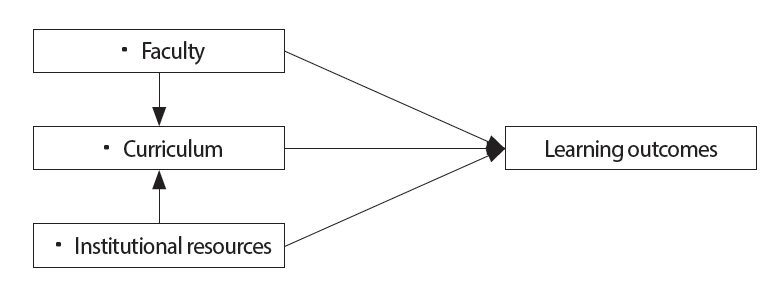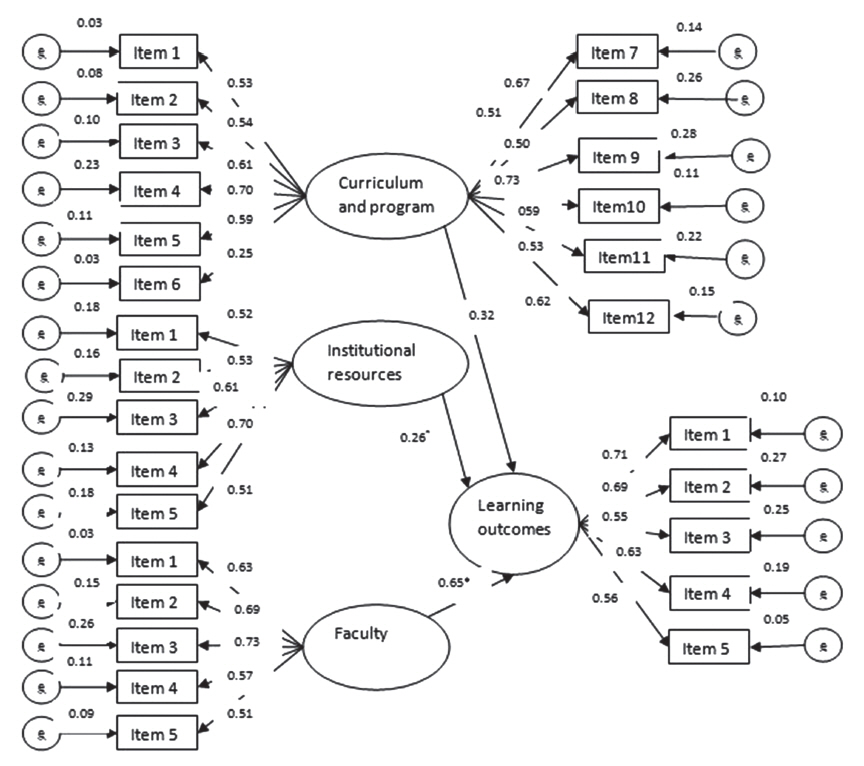J Educ Eval Health Prof.
2017;14:16. 10.3352/jeehp.2017.14.16.
Evaluation of an undergraduate occupational health program in Iran based on alumni perceptions: a structural equation model
- Affiliations
-
- 1Faculty of Medicine, Iran University of Medical Sciences, Tehran, Iran.
- 2Social Determinants of Health Research Centre, Department of Occupational Health, Semnan University of Medical Sciences, Semnan, Iran. dehdashti@semums.ac.ir
- 3Department of Occupational Health, Kashan University of Medical Sciences, Kashan, Iran.
- KMID: 2406679
- DOI: http://doi.org/10.3352/jeehp.2017.14.16
Abstract
- PURPOSE
Evaluating educational programs can improve the quality of education. The present study evaluated the undergraduate occupational health program at the Semnan University of Medical Sciences in Semnan, Iran, with a focus on the associations between alumni perceptions of the learning environment and the outcomes of the occupational health program.
METHODS
A cross-sectional questionnaire survey was conducted among alumni of the undergraduate occupational health program. We asked alumni to rate their perceptions of the items using a 4-point Likert scale. The associations between alumni perceptions of the educational program and curriculum, faculty, institutional resources, and learning outcomes were modeled and described using structural equation modeling procedures.
RESULTS
A descriptive analysis of alumni perceptions indicated low evaluations for the administrative system, practical and research-based courses, and the number of faculty members. We found that a structural model of the evaluation variables of curriculum, faculty qualifications, and institutional resources significantly predicted undergraduate educational outcomes. The curriculum had direct and indirect effects on learning outcomes, mediated by faculty.
CONCLUSION
The findings of our study highlight the usefulness of the structural equation modeling approach for examining links between variables related to the learning process and learning outcomes. Surveys of alumni can provide data for reassessing the learning environment in the light of the professional competencies needed for occupational health graduates.
Keyword
Figure
Reference
-
References
1. Bredtmann J, Crede CJ, Otten S. Methods for evaluating educational programs: does Writing Center participation affect student achievement? Eval Program Plann. 2013; 36:115–123. https://doi.org/10.1016/j.evalprogplan.2012.09.003.
Article2. European Agency for Safety and Health at Work. Mainstreaming occupational safety and health into university education. Luxembourg: Publications Office of the European Union;2010.3. Lewallen LP. Practical strategies for nursing education program evaluation. J Prof Nurs. 2015; 31:133–140. https://doi.org/10.1016/j.profnurs.2014.09.002.
Article4. Arimoto A, Gregg MF, Nagata S, Miki Y, Murashima S. Evaluation of doctoral nursing programs in Japan by faculty members and their educational and research activities. Nurse Educ Today. 2012; 32:e1–e7. https://doi.org/10.1016/j.nedt.2011.06.007.
Article5. Dehdashti A, Mehralizadeh S, Kashani MM. Incorporation of project- based learning into an occupational health course. J Occup Health. 2013; 55:125–131. https://doi.org/10.1539/joh.12-0162-oa.
Article6. Brown T, Williams B, McKenna L, Palermo C, McCall L, Roller L, Hewitt L, Molloy L, Baird M, Aldabah L. Practice education learning environments: the mismatch between perceived and preferred expectations of undergraduate health science students. Nurse Educ Today. 2011; 31:e22–e28. https://doi.org/10.1016/j.nedt.2010.11.013.
Article7. Watson MK, Lozano R, Noyes C, Rodgers M. Assessing curricula contribution to sustainability more holistically: experiences from the integration of curricula assessment and students’ perceptions at the Georgia Institute of Technology. J Clean Product. 2013; 61:106–116. https://doi.org/10.1016/j.jclepro.2013.09.010.
Article8. Lidice A, Saglam G. Using students’ evaluations to measure educational quality. Procedia Soc Behav Sci. 2013; 70:1009–1015. https://doi.org/10.1016/j.sbspro.2013.01.152.
Article9. Cobb KA, Brown GA, Hammond RH, Mossop LH. Alumni-based evaluation of a novel veterinary curriculum: are Nottingham graduates prepared for clinical practice? Vet Rec Open. 2015; 2:e000116. https://doi.org/10.1136/vetreco-2015-000116.
Article10. YuekMing H, Manaf LA. Assessing learning outcomes through students’ reflective thinking. Procedia Soc Behav Sci. 2014; 152:973–977. https://doi.org/10.1016/j.sbspro.2014.09.352.
Article11. Kline RB. Principles and practice of structural equation modeling. 3rd ed. New York (NY): Guilford Press;2011.12. Victor G, Ishtiaq M, Parveen S. Nursing students’ perceptions of their educational environment in the bachelor’s programs of the Shifa College of Nursing, Pakistan. J Educ Eval Health Prof. 2016; 13:43. https://doi.org/10.3352/jeehp.2016.13.43.
Article13. Reinhold K, Siirak V, Tint P. The development of higher education in occupational health and safety in Estonia and selected EU countries. Procedia Soc Behav Sci. 2014; 143:52–56. https://doi.org/10.1016/j.sbspro.2014.07.356.
Article
- Full Text Links
- Actions
-
Cited
- CITED
-
- Close
- Share
- Similar articles
-
- The Relationships Among Occupational Safety Climate, Patient Safety Climate, and Safety Performance Based on Structural Equation Modeling
- Model Setting and Interpretation of Results in Research Using Structural Equation Modeling: A Checklist with Guiding Questions for Reporting
- The Structural Equation Model of Intention to Discontinue Drinking Highly Caffeinated Beverage of Undergraduate Students
- Construction of the Structural Equation Model on Binge Drinking among Korean Undergraduate Students
- Evaluation of the Quality of Occupational Health and Safety Management Systems Based on Key Performance Indicators in Certified Organizations



